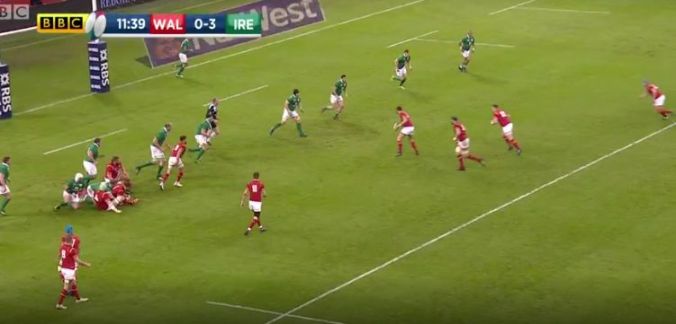The Welsh coaching team has rightly had its critics over the last few years (including us), but they should be given credit for the way Wales beat Ireland in this weekend’s opening 6 Nations fixture in Cardiff.
Most of us were expecting Wales to suffer defeat against an Ireland team brimming with confidence after some big wins against the southern hemisphere over the last 12 months.
What we did see were the first positive signs of an evolving Welsh approach to the game; a couple of strong driving mauls, a willingness to run from deep if the pass was on and the second high quality try from a set piece this 6 Nations.
This article will focus on another area of the game Wales have been criticised for – their lack of creativity at outside half.
Biggar and flat play
Dan Biggar’s strengths are around his game management, his defence and his kick chase and collect, but his ability with the ball in hand is one of the reasons why the Welsh team struggles to create opportunities against the best teams.
Biggar traditionally receives the ball quite deep, which gives him time to get his kick in but makes it easier to defend against. The opposition know he rarely attacks with the ball and by passing to his team mates behind the gain line, he allows the opposition to line up the tackle.
His Ospreys’ colleague Sam Davies excels in playing flat to the opposition line and using his sharp hands and footwork and excellent “footballing” brain to put runners through holes and in to space.
The first half of the Wales – Ireland game was interesting in that Dan Biggar seemed to be playing much flatter to the gain line that he traditionally does with Wales. Here are a couple of examples.
In the first example, Wales turn the scrum to expose the Irish right hand defence. Biggar is already on the move and Webb’s pass to him is flat at best. This is simple, but effective rugby with Biggar hitting the ball at pace right on the gain line with the Irish defence struggling to come across.

In the second example, Wales are attacking the Irish line and Biggar takes the ball with about 3 metres to the Irish defensive line.

The important aspect is Biggar takes the ball right to the Irish line before releasing to Jon Davies (scrum cap), who runs at the gap and not the man.

The tactic though brought Wales some big problems as we can see in the next couple of examples.
With 7 minutes on the clock Webb finds Biggar who is back in his usual deeper position. Sexton comes racing out of the line but Biggar seems unaware of Sexton’s positioning and focuses on the play – a flat pass to Alun-Wyn Jones.
In the second example (below), we see pretty much the same pattern.
This time Biggar takes the Webb pass flatter and has his eyes on the ball to Moriarty who is hitting the gap. Perhaps the fact he is being asked to play an unnatural style of rugby plays on his mind because once again he is not aware of Sexton’s positioning – it’s as if he has lost that split second of additional time he would have had by playing a bit deeper.
The other interesting thing to note about this second example is that the ball was won at the front of the lineout, which means it has to travel a relatively long way before it even gets to Biggar. This means he has even less time to make his move and play the ball.
Wales playing off Webb
The Welsh coaches seemed to be nervous about the number of poor passes and interceptions from Biggar and the problems the Irish umbrella defence was causing, so in the 2nd half they changed tactic.
Instead of now playing Biggar flat and having runners off him, it was the job of Rhys Webb to be the primary decision maker and distributor. We now had forwards taking balls from set piece and phase play directly from Webb, with Biggar only used later in the move.
Wales also started to revert more to their traditional kick and press game as the clock ticked down, but using Webb as the primary kicker. Between the 60th and 63rd minute of the game Webb box kicked 3 times to try and pen back the Irish team.
The more expansive Welsh approach with Biggar on the gain line that we saw in the first half, had been replaced by a more pragmatic, territory-orientated game with Webb as the main play maker.
It is testament to how far Webb’s game has developed over the last few years, that he is comfortable taking on this responsibility for the game management. He gave away two cheap penalties and made some errors but his ability to change the game in an instant means he is now one of Wales’ most important players.
To follow us on Facebook like us here.